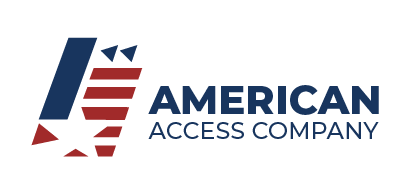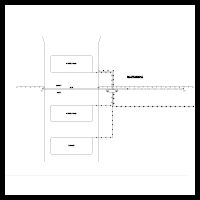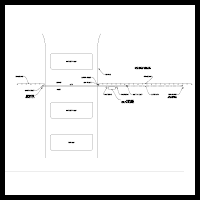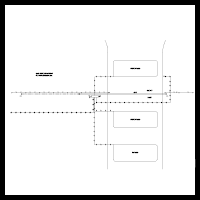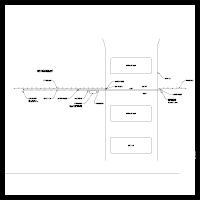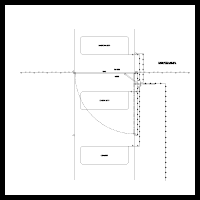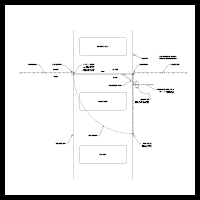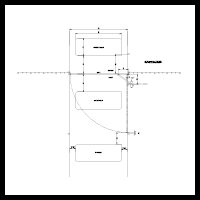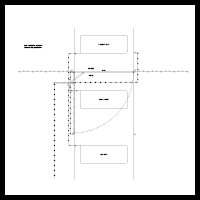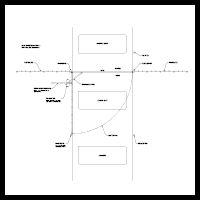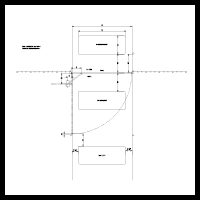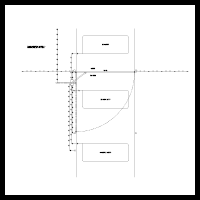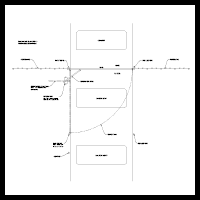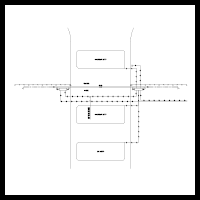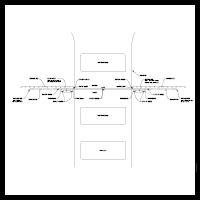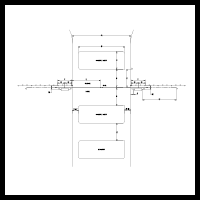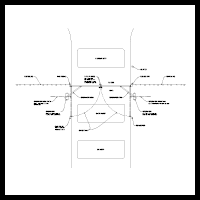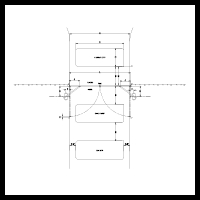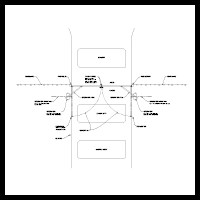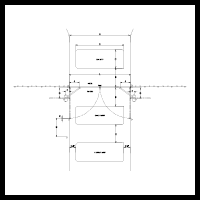System Design, CAD Files, Specifications
American Access Company offers designers, architects, and end-users all the tools necessary to design your next automated gate access control system. We start with our design guide and offer multiple design drawings and a downloadable Gate Specifaction document that can be incorporated into your design drawings.
How To Select Your Automated Gate & Access System – Your Ultimate System Design Guide
An automated electric gate can be as simple as pushing the button on a garage door opener to open and close your gate. Automatic gates can also be as sophisticated as a computerized entry and vehicle proximity reader where your system knows your car and automatically opens the gate as you approach while recording, managing and sharing every transaction.
This “How To” article will address each step in the design of your automated gate system from the selection of the gate to the gate devices and accessory components. The steps include:
Part One – Selecting Your Type and Style of Gate
Part one of this How To article is to review the types of gates relative to how these gates accommodate your site. There are two basic types of gates that can be easily automated: Cantilever slide gates and swing gates.
Swing gates are more popular for residential jobs. Home owners prefer the look of the estate type entry where the gate swings open to welcome you. These gates are available in both single and double swings. Some considerations if you have selected an automated swing gate:
- Should the gate swing in or out – Automated swing gates may swing either way. However, the vast majority swing out. This is because most driveways slope down from the house to the street. Swing gates must remain level as they swing open. If the gate is swinging in, it may bottom-out on the driveway before it swings all the way open. This may be an issue if your approach from the street to the gate is short. There should be at least two car lengths of room as guests are prone to back-up when they see the gate open out. If there is not enough distance from the gate to the adjoining street, guest may be backing-up into traffic.
- Consider a double swing gate over a single swing – Single swing gates only require one gate operator. Double swing gates will require two gate operators that must communicate with one another. Though the cost of two operators is more expensive, a double swing gate will have a much shorter swing due to the gate opening being split between the two leafs. This has multiple benefits.
- A larger single leaf may require a larger gate operator compared to powering two smaller leafs. Automated swing gates may serve as snow plows in the winter. The larger single leaf may struggle in pushing even a couple inches of snow.
- If your gate opens out, two smaller leafs will be less intimidating to guests when the gate begins to open out toward them. Thus, first-time guests may be less prone to panic and hastily back-up into another vehicle or on-coming traffic.
- Consider all the elevations – A 20’ opening with a single gate leaf means that the leaf will extend over 20’ of driveway both in the open and closed position. If there is any slope, the leaf may bottom-out as it swings open or leave considerable gaps under the gate when in the closed position. If the opening is split between two 10’ leafs, any gaps or concerns of bottoming-out are minimized. You should verify the elevations of the ground beneath the entire travel of the gate. The highest elevation will be your benchmark. The gate will be set a couple inches above this elevation. This could leave the gate a considerable distance off the ground in the closed position if the ground slopes up as the gate travels open. This is common as most site elevations travel upward from the street to the building.
- The sweep or swing of the gate. Swing gates will cover a lot of ground when swinging from the closed position to the full open position. This sweep may interfere with other items such as traffic lanes, parking stalls, parked cars, etc. Many swing gates will open a full 180 degrees which allow you to store the gate against the fence line when open. This is good news until you have to close gate and it must swing through a parking stall occupied by a park car left overnight.
- Overall reliability relative to use. Automatic swing gates may not be as reliable as automatic slide gates. It is simple physics. A slide gate has a great deal less resistance in the form of snow and wind loads. Its profile slices through conditions as it slides back and forth, whereas a swing gate must push an area equal to the overall square footage of the surface of the gate. Slide gates can easily slice through moderate snow fall whereas swing gates will quickly build-up snow piles in front of the leaf. This will ultimately cause the gate operator to think it is hitting something and go into “safe mode.”
- More secure option. Automated swing gates may not be as secure as automated slide gates. Unless equipped with an electric mechanical or magnetic lock, automated double swing gates may be easily pried-open to allow someone to squeeze between the two leafs. Slide gates may be equipped with a receiver that allows one gate to slide into another or into a receiver post. This makes it very difficult to pry open the gate.
Slide gates may be more popular in commercial applications where security and reliability are paramount. Slide gates are available in both single and double swing applications. If you are thinking about a slide gate for your business or home, you should consider the following:
- Storage. Slide gates are typically 50% larger than the actual opening. So, a 16’ opening would require a 24’ overall gate leaf. This extra 8’ of gate is called the tail or counter balance. It also allows the gate to be easily attached to a slide gate operator. If selecting a slide gate, you must be sure that you have adequate storage for the gate in the open position.
- Elevations. Slide gates must be installed level in accordance with ASTM F 2200. This is critical so that the gate does not slide under its own weight which could cause a significant injury. That being necessary, you should review the elevations of the ground below the entire travel of the gate from open to closed. The highest elevation will be your benchmark. The gate will be set a couple inches above this elevation. If the highest elevation is at the tail of the gate and it slopes down through the opening, the gate could be several inches to a foot off the ground at the opening.
Once you have decided on the type of gate between a swing and slide gate, you are ready to choose the style of your gate. Both cantilever and swing gates can be designed as a simple means of security that includes chain link fabric over a galvanized framework. Both type of gates can be highly ornate to include decorative pickets, finials, circles, letters and custom designs. There are literally thousands of different designs. However, each design may impact the overall size and weight of the gate. These two factors will play a significant role in the selection of the gate operator.
In accordance with ASTM F 2200 and UL 325, there are some gate design considerations that should be closely adhered to avoid any unnecessary hazards.
- The gate should not have any obstruction or design component protruding out from the gate that may create a hazard below 8’.
- Slide gates should not have openings greater than 2 ¼” in the gate.
- All gates should have a smooth bottom with no pickets protruding.
- All gates should be prevented from falling if disconnected from the gate hardware.
- Swing gates should not create an entrapment area less than 16” when swinging open.
- Swing gates should not have an area greater than 4” from the post or column to the hinge point.
- Gate receiver hardware should not protrude out into the opening.
- Gates should have a positive stop at the full open position.
Now that you have selected your type and design of gate, you are ready for part two of this How To article: How To Select Your Gate Operator.
Part Two – Selecting Your Gate Operator
Gate operators are designed to move gates in two directions. This requires an electric gate motor. The bigger the gate, the more powerful the gate motor. Gate operators are manufactured to meet specific gate design characteristics. These include gate size, weight, wind loading and frequency of use. Each gate opener manufacturer provides an easy to use chart that assists you in selecting your gate opener based on these characteristics:
- Size. The overall size of the gate is generally the leading characteristic in determining your gate operator selection for both swing and slide gates.
- Weight. Unless you have a very custom ornamental gate with a lot of heavy infill, you will rarely weight-out your gate before you size it out.
- Wind loading. Wind loading is rarely addressed by manufacturers but it is a real concern. If your gate as a solid opaque surface that receives heavy winds, rain or snow, you may want to contact your local gate operator installer for recommendations on oversizing your gate operator.
- Frequency of use. Most gate operators today are continuous duty operators. However, some DC versions have limited use due to battery life.
Once you have narrowed down your gate operator selection based on the above performance characteristics, you must select your operator on three more important electrical criteria. Before doing so, you should identify where you are going to pull power for your gate operator.
- Gate operators require a dedicated circuit and required number of amps. Do not attempt to daisy chain your gate operator into other applications. The amount of start-up power for an electric motor is substantial so it may easily trip the breaker when combined with other usage.
- Gate operators are available in single and three phase power. Three phase power is preferred because it is a more efficient and consistent form of power. Your facility may have three phase power but not in the front of the building where the administrative offices are located. Thus, you may have to pull this power from the rear of the property where it is located to power machinery. Single phase power has one hot and a neutral whereas three phase has three hots and a neutral. Thus three phase wire is expensive.
- Gate operators are available in a range of common voltages. 120, 240, 208 & 460. You should always make sure your circuit is designated within 10% of the gate operators rated voltage.
Now you have selected your gate opener based on the performance characteristics and electrical requirements. Closely follow the manufacturer’s recommendations for installation. Having successfully installed over 10,000 gate operators, there are some key pointers we would like to mention.
- Gate operators require proper anchoring, footings, and mechanical connections. Please consider using a professional installer to set and connect your gate operator.
- The location of the gate operator relative to the gate is critical. Closely follow the manufacturer’s recommendations for these dimensions. Even the slightest variation may result in operator failure and create a safety concern.
- Only use a licensed electrician for bringing power to the gate operator. Like any piece of motorized equipment with circuitry, gate operators are very fickle about meeting the required number of amps and voltage. Too little or too much may cause you to quickly blow a circuit board or motor. Electricity drops-off when traveling long distances. Since most gate operators are located several meters from the power source, a licensed electrician will help evaluate and provide the proper wire size and starting voltage for the distance traveled.
- Gate operators require inherent and external safety devices. The operator will not function unless these devices are properly installed.
- Gate operators require programming prior to operation. Follow the manufacturer’s step-by-step procedure in properly programming the gate operator.
- Today’s gate operators are sophisticated pieces of equipment. However, this equipment will not operate without additional external control devices that are not included with the gate operator.
Part Three – Selecting Your Automated Gate Components
There is a wide range of automatic gate components. To help you narrow down your selection specific to your project, you should consider the following approach in the design of your system.
The first item to consider is if your gate will be secured during business hours. Regardless if the project is residential or commercial, you must decide if your gate will be open or closed during the day. “Day” in this instance can be defined as business hours or that period of time when you would reasonably expect non-family members to need access through your gate. This may appear to be an unusual place to start the decision-making process, but it is a critical first fork in the road in selecting your automated gate devices.
Automated gate control systems that are closed during the day or business hours will typically require some form of point of elevated entry communication device that communicates with others via cell phone, landline or intercom. In addition to the ability to communicate, these devices will also include point of entry access via keypad, remote or card reader. These devices include telephone entry devices, intercoms and computerized devices.
If your gate is open during the day, you may consider basic access control devices that do not communicate with others. These devices may be standalone keypads, key entry, push button and card readers.
The next consideration is the type of individuals who will require access through your gate while it is closed. Please consider if you need access for the following individuals.
- Family members or key employees. These are typically individuals who are given fully 24/7 access through the gate.
- These are individuals who are given restricted access based on scheduled regular time periods.
- Scheduled services. These are individuals who are given a limited number of access attempts for limited access periods. These may include cleaning services and the infrequent repair events. The individuals are limited to use the access code for a specific number of usages.
- Guests and non-scheduled services. These may include one-time guests who may or may not have scheduled a visit, postal delivery, food delivery, etc.
The next step in the selection of your electric gate devices is that entry and exit are reviewed separately. In other words, how each individual gains access to enter the property may vary from how they exit the property. Exiting the gate may not require the same level of scrutiny in deciding if the individual can open the gate. This will save greatly on costs and time.
The final step before actually selecting your devices is to understand that automated gate devices are divided into two types: Standalone and Computerized or programmable devices
Standalone devices: Standalone devices are not connected to other devices. These devices typically are used to control a single gate. Standalone devices are typically more cost competitive but also very limited in programming options and generating any reporting. Most standalone devices are programmed at the unit. Most importantly, standalone devices rarely have the ability to be tied to a single user and are not given a user ID. A standalone keypad is connected directly to the gate operator. The most common applications are single family dwellings and business with limited after-hours access.
Computerized Programmable devices: Computerized devices typically communicate and are connected to a master controller. These devices can be connected to multiple other devices and gates. These devices may be programmed via personal computer connected to the master controller via the internet. Multiple users may be set-up in the master controller to have defined levels of access by gate and time zone. These computerized devices will also have a reporting mechanism where the controller is saving every entry and exit by each user. Often, these reports can be formulated by user, time zones, and gate. The most common applications are apartment complexes and gated communities.
Access control devices are available in both standalone or computerized programmable. If you have given some thought to if your facility must be secured 24/7 and the various individuals who will need access to your gate, you are now ready to select your access control devices for entering and exiting your automated gate. Below is a cursory list of the gate access control devices available today.

Gate Transmitter and Receiver
The most widely used access control device is the gate transmitter and receiver. The transmitter comes in a wide variety of options. Most commonly known as a “garage door opener,” the transmitter is typically a small gate remote that clips to the visor. One push and it sends a radio signal to a receiver in the gate operator. Once the signal is received and verified, the receiver sends a message to the operator to open and/or close the gate. Gate transmitters can be single channel or multichannel to control several devices. Many of today’s automobiles are equipped with a “Homelink” transmitter system that may be programmed to open your gate operator. There is even a hands-free device that automatically opens the gate when you approach without having to push any buttons.
Pedestal Mounted Keypad
Another widely used gate device is the pedestal mounted keypad. As a standalone device or computer programmable, the keypad requires a 3-5 digit code to access the gate. A single code may be used for all access attempts or individualized codes may be programmed to provide better security. The downside to a keypad is that codes may be shared with no limitations. A programmable keypad can track these codes and respective entry attempts.
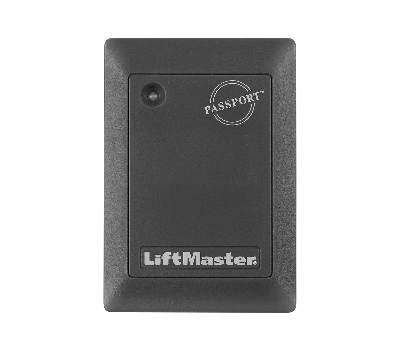
Proximity Card Reader
For greater security, a popular option is a proximity card reader. As a standalone device or computer programmable, the card reader requires cards be given to those that require entry. You simply swipe the card in front of the pedestal mounted reader device. Once the card is verified, the gate can be accessed. Individualized programmable cards and card readers better control access and track access attempts.
Standalone Key Switch
A simple gate solution is a standalone key switch. Those that require access will be provided with a key. A momentary contact key switch will require you to twist the key, release and remove. A signal will be sent to the gate operator to open or close the gate. A constant contact key switch will require you to twist the key to an open or closed position and then remove. This will send a constant contact to the gate to open and keep the gate open until the key switch as been returned to the closed position. Lost or stolen keys will require you to rekey the device.
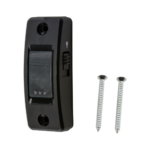
Push Button
For those not necessarily concerned about security but want a gate that is closed to keep pedestrians from making a wrong turn, a simple push button may be enough. Push buttons are available in a single button to open and close the gate. A two-button device with one button to open and one to close. A three-button device with one button to open, one to close and one to stop the gate. All of these button devices are available with a lock-out key device. Often times these button devices are placed out of sight.
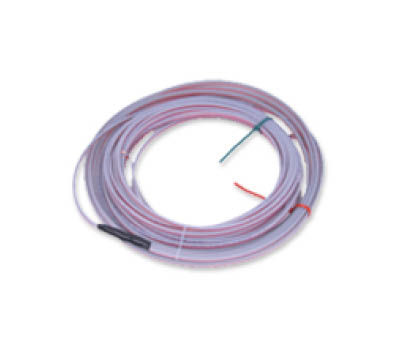
Ground Loops
Ground loops are an excellent hands-free means to opening and closing gates. More than likely, these loops are placed on the inside of the gate. This allows for vehicles to pull-up on the loop to signal the gate to open. These interior loops used to open a gate are called “free exit” loops.
- Another option is to tie a loop to another access control device. This requires that a vehicle must be sitting on top of the loop for the access control device to be enabled to open the gate. These loops are called “presence loops.”
- A third type of loop is used to keep an open gate open and reverse a closing gate to the fully open position. These loops are called “obstruction loops” and are most commonly used to prevent a gate from closing on a vehicle.
- A fourth type of loop is a “shadow loop.” These loops keep an open swing gate open or prevent the gate from opening. Shadow loops are not operational as the gate passes over the loop, thus not sensing the gate and reversing.
- Loops are formed with a continuous wire that is in the shape of a loop in the ground. The loop wire is energized thus creating a magnetic field. When the magnetic field is interrupted by a large mass of metal, its detector sends a message to the gate to open, close, stop or whatever function you select.

Intercoms
If your gate is closed during business hours, you may need the basic ability for point of entry communication with those inside the facility that can open the gate. The most basic approach to this entry situation is an intercom system. Gate intercoms may be hardwired, radio frequency or Wi-Fi enabled. Basic intercoms will include the ability to not only communicate with those at the gate but a call button to initiate the conversation from the gate and a button to open the gate from within the facility. Intercom systems will include at least two components; one component installed at the gate and another unit installed within the facility.
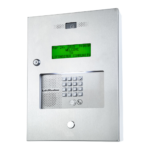
Telephone Entry Sytem
The next level up from the basic intercom is the telephone entry system for your gate. This system is advanced beyond the intercom system in its ability to connect point of entry communications with others via a phone number. Telephone entry systems include a component installed at the gate. This unit may be connected with a dedicated phone line, shared phone line or Wi-Fi enabled. The unit will include a “call button” that is programmed to call those authorized to open the gate. Those at the gate will communicate with others from the unit over the phone. Those on the phone will select one of the numbers on their keypad to open the gate. Telephone entry systems will also include a keypad for entrants to use a code to open the gate or select alternate authorized phone numbers. Telephone entry systems will typically also include some advanced features such as call waiting, call forwarding, one-time programmable entry codes, programmable time zones for the gate to be open, etc.

Computerized Entry System
The most advanced access control device is a computerized entry system. Computerized entry systems will include a primary unit that includes the circuitry for processing and storing information. Connected to this primary unit may be multiple secondary units that utilize the primary unit for validation and recording entry requests. Computerized entry systems will be connected via a data line or Wi-Fi. Programming may be completed remotely or at the unit via a laptop. Computerized entry systems allow you to control multiple points of entry that can include gates and doors. The system allows you to program each point of entry parameters and individual user parameters. Computerized entry systems will often have the same appearance and functionality as a telephone entry system but will also include more specific point of entry and user parameters, and high-level reporting functionality.
Below are some examples of common automatic gate sites that either fit a standalone or computerized programmable system.
- The facility is a food service manufacturing plant. Due to FDA regulations, it must be closed during business hours. The operation has several key employees, over 50 regular employees, scheduled services and non-scheduled deliveries. This facility will undoubtedly need an ability to communicate from the gate to those who have an ability to open the gate.
It may not be practical to anticipate someone will be constantly present to allow access. In that event, you will definitely want to select a computerized entry system where you can preprogram access for each type of individual.
Key employees will need access for after hours as they may be working long days. However, company leadership may want to know when these individuals are still coming and going.
With 50 regular scheduled employees, the FDA mandates that you will have to regulate and record entry and departure for these employees. Scheduled services such as supplier deliveries and customer pick-ups should be controlled and recorded.
Non-scheduled services such as UPS, Fed-Ex and repair services will not have access unless allowed entry by the facility.
- Another facility may be an equipment storage lot for a construction company. This facility should also be closed during the day. However, only a handful of employees may need access to the lot. In this event, a standalone keypad may be used to allow access.
Once you have selected your gate, gate operator, gate opener and gate control devices, you are now ready to design your pedestrian safety and vehicle detection system. You are now ready to begin How To Select Your Automated Gate – Part 4 Providing the necessary and required safety components in support of your system.
Part Four – Providing a Safe Automated Gate
The automated gate industry has a long history of addressing safety as it pertains to automated access gates and operators. The industry has teamed with Underwriters Laboratories to provide a standard for all installations. This standard is UL325. The new UL325 standard is the standard for door, drapery, gate, louver and window operators. The standard was created by industry leaders working with Underwriters Laboratories back in 2000.
To cover all access control operations, the UL 325 standard was divided into four classifications. Each grouping is based on a unique type of access control system and provides safety requirements specific to each grouping. The groupings are as follows:
Class I – Residential Vehicular Gate Operator
A vehicular gate operator system intended for use in a single-family dwelling or related parking garage or parking area.
Class II – Commercial/General Access Vehicular Gate Operator
A vehicular gate operator system intended for use in a commercial application that includes multi-family housing, hotel, garages, retail store, or other building servicing the general public.
Class III – Industrial/Limited Access Vehicular Gate Operator
A vehicular gate operator system intended for an industrial application or building, manufacturing, loading dock area or other locations not intended for the general public.
Class IV – Restricted Access Vehicular Gate Operator
A vehicular gate operator system intended for a guarded industrial operation, correctional facility, airport or other restricted access not servicing the public. Unauthorized access is prevented and the operation is under direct supervision by security personnel.
| A key part of the UL 325 standard is a table (Table 31.1) that summarizes the entrapment device options for different classes of operators of the various types of gates included in the standard. Refer to the table as you read about the provisions that are described in the following sections. Usage class | Gate operator category | ||||
| Horizontal slide, vertical lift, and vertical pivot | Swing and vertical barrier (arm) | ||||
| Primary type a | Secondary type a | Primary type a | Secondary type a | ||
| Class I and II | A | B1, B2, or D | A, or C | A, B1, B2, C, or D | |
| Class III | A, B1, or B2 | A, B1, B2, D, or E | A, B1, B2, or C | A, B1, B2, C, D, or E | |
| Class IV | A, B1, B2, or D | A, B1, B2, D, or E | A, B1, B2, C, or D | A, B1, B2, C, D, or E | |
| Note – The same type of device shall not be utilized for both the primary and the secondary entrapment protection means. Use of a single device to cover both the opening and closing directions is in accordance with the requirement; however, a single device is not required to cover both directions. A combination of one Type B1 for one direction and one Type B2 for the other direction is the equivalent of one device for the purpose of complying with the requirements of either the primary or secondary entrapment protection means. | |||||
| Entrapment protection types: | |||||
| Type A – Inherent entrapment protection system. This would include obstruction sensitivity device that reverses or stops the gate upon sensing it has been obstructed. | |||||
| Type B1 – Provision for connection of, or supplied with, a non-contact sensor. Photoelectric eyes are available in both infrared and photoelectric. Devices will include hard wired sending and receiving units or a single wired sending/receiving unit that uses a reflector to return the signal on the other side of the opening. | |||||
| Type B2 – Provision for connection of, or supplied with, a contact sensor. This would include gate edge protection. Gate edges are sensors placed along the edge of the gate that when impacted will send a signal to the operator to stop or reverse. | |||||
| Type C – Inherent adjustable clutch or pressure relief device. | |||||
| Type D – Provision for connection of, or supplied with, an actuating device requiring continuous pressure to maintain opening or closing motion of the gate. | |||||
| Type E – An audio alarm. |
Gate Definition and Types
UL 325 defines a gate as “a moving barrier such as a swinging, sliding, raising, lowering, rolling, or the like, barrier that is a stand-alone passage barrier or is that portion of a wall or fence system that controls entrance and/or egress by persons or vehicles and completes the perimeter of a defined area.” The main types of gate operators/systems addressed in UL 325 are barrier, vertical pivot gate, horizontal slide gate, swing gate and vertical slide gate. It is important to note that all gates included in UL 325 are defined as vehicular gates and NOT PEDESTRIAN GATES. Property owners are expected to provide a separate entrance for pedestrian access.
UL 325 defines the allowable entrapment protection options for each class as follows:
1) Each class must have primary and secondary entrapment provisions;
2) Each class must have different types of protection for the different classes of operators as well as for the different categories of operators; and
3) The same type of device cannot be used for both primary and secondary protection.
An exception to compliance with the provisions of Table 31.1 has also been noted in the standard. An operator considered exempt would require all of the following:
1) Operates a vehicular barrier (arm) that is not intended to move toward a rigid object closer than 2 feet;
2) Does not have a pinch point between moving parts by virtue of the operator’s design or complying installation; and
3) Is not required to be provided with means to protect against entrapment.
Provisions of Note Regarding Gate Operators
We have identified the following notable provisions included in UL 325 that affect gate operators and related safety devices.
1. Class I and Class II operators must have an audio alarm which shall function if 2 sequential activations of the entrapment protection device occur. The “2 sequential activations” is noteworthy in that it is hoped that “nuisance” alarms will be kept to a minimum while still enhancing safe operation.
2. Class I and Class II slide gate operators shall not exceed a speed of 1 foot per second when the operator is pulling 75 pounds or more. Since both classes listed involve general public usage, this maximum established speed strikes a balance between any perceived security issue (a person immediately following the party controlling the gate) and any danger from a person being struck by a gate.
3. A Type B1 or B2 device serving as a Primary Safety Device shall be monitored for the presence and correct operation of the device, including the wiring to it, at least once during each open and close cycle. This requirement is included because these types of safety devices are often used as backup safety devices.
4. Manufacturers will be required to specify a brand and model number of external sensors compatible for connection to an operator. This provision arose from concern over the gate operator external devices acting in tandem as a system, with a fault rate of 6 failures in 1 million hours of use (which equates to 115 years of continuous operation).
5. After sensing an obstruction, reversing must begin within 2 seconds. This requirement is intended to keep a person from being entrapped in a stationary position by the gate system. After the first contact the gate must reverse and travel a minimum of 2 inches. If there is a second contact, the gate must stop, and requires a wired device to reset the operator.
After any obstruction reversal by either an A or B2 device, the timer-to-close is disabled until reset. Both A and B2 devices sense direct gate contact with an obstruction, and the devices must perform their intended function without interference from a timer-to-close action.
7. Stop the gate upon sensing a second sequential obstruction, and then not operate until an intended hard wired input is received in most situations, depending upon the combination of types of primary and secondary entrapment protection devices that are used.. A person within the line of sight of the gate must see what has caused the second sequential obstruction and must resolve this obstruction before operating the gate.
1. If a Type C device is chosen, swing gates must not exert more than 40 pounds of force after initial start-up. The reasoning here is similar to the reasoning given for the speed limitation for horizontal slide gates.
Effect on Installations
The new provisions will have several effects on gate and fence dealers:
1. Gate and fence dealers should look for an indication of the Class of each operator, which will be specified by the gate operator manufacturer.
Fence dealer sales personnel must match the site application with the Class of operator. The gate operator manufacturer should be contacted if there is any question about the site application.
3. Both primary and secondary safety devices must be provided and matched to both the operator and site conditions. Although the gate operator manufacturer will either provide or specify these devices, the gate/fence dealer should insure that they are installed and correctly matched. Any questions should again be directed to the gate operator manufacturer.
4. Warning signs must be permanently affixed to the gate panel. UL 325 includes specific requirements on the format, content, and placement of these signs.
Factors Related to Gate Construction and Installation
Vehicular gate operators should ONLY be used on vehicular gates and never pedestrian gates.
Adequate clearance should be provided between a swinging gate and adjacent structures to reduce risk of entrapment.
A sliding gate should work smoothly with easy rolling/movement in both directions, prior to the installation of the operator.
Controls should be as far away from the gate as possible, at least 6 feet from the gate, to prevent “reach-through” occurrences.
Warning signs and placards must be installed and be visible in the area of the gate.
See DASMA TDS-370 for information about gate construction and ASTM F2200, Standard Specification for Automated Vehicular Gate Construction.
Device-Specific Installation Instructions
There are also specific installation requirements for certain types of entrapment protection devices. These specific requirements emphasize the care and attention that each device must be given prior to and during installation.
For gate operators utilizing non-contact sensor devices (Type B1), instructions should be consulted for placement for each application, care should be exercised to reduce the risk of nuisance tripping, and one or more of these devices must be installed where the risk of entrapment or obstruction exists.
For gate operators utilizing contact sensor devices (Type B2), several requirements are spelled out in UL 325.
One or more contact sensors shall be located at the leading edge, the trailing edge, and also post mounted both inside and outside of, a vehicular horizontal slide gate; at the bottom edge of a vehicular vertical slide gate; and at the entrapment point of a vehicular vertical pivot gate.
A wired contact sensor shall be located, and its wiring arranged, so that communication between sensor and gate operator is not subjected to mechanical damage. A wireless contact sensor shall be located where the transmission of the signals is not obstructed or impeded by building structures, natural landscaping or similar obstructions, and shall function under the intended end use conditions.
For gate operators utilizing a continuous pressure activating device (Type D), controls must be placed so that user has full view of the gate area when the gate is moving. A placard must be placed adjacent to the controls and no other activation device shall be connected. Most importantly, an automatic closing device shall not be employed.
Statements in Manufacturer’s Instructions Concerning Installation
Gate and fence dealers can expect to see in gate operator instructions the following statements:
1. The operator must be appropriate for the construction of the gate and the usage class of the gate. The appropriate primary and secondary safety devices to be used are a major consideration to support this requirement.
2. All openings of a horizontal slide gate, and the portion of the fence where the slide gate passes, must be guarded or screened. These specific requirements in UL 325 that govern this provision were developed to address “reach-through” occurrences. For example, slide gates must have a protective cover 48 inches in height extending from the bottom of the gate/fence panel.
3. All exposed entrapment points must be eliminated or guarded. It is up to individual gate and fence dealers to identify these points on a product-by-product basis, or on a job-by-job basis.
4. Guarding must be supplied for exposed rollers. Exposed rollers are regarded as potential pinch points
Part Five – CAD Files & Specifications
Automated access control systems can be complicated and require planning on behalf of the designer. American Access Company makes it easy by providing a complete set of equipment, dimensions, electrical design drawings, and specifications. Our drawing sets are broken-out into the four most common access control systems.
- Single swing gate
- Double swing gate
- Single slide gate
- Double slide gate
Each drawing demonstrates a plan view of the necessary items to provide a complete and code compliant system. A gate specification sheet is also available for download. The Gate Specification Sheet can be used in your plan and modified for your needs. These drawings not only provide the necessary layout but will assist in helping designers select the necessary equipment and plan for its place on their project site. The electrical layout drawings are priceless in providing the necessary electrical conduit, wire and wiring for all construction trades to be mindful and provide for these necessary items. If your access control system is not represented by one of our four sets, please contact us and we will happily assist you in a custom set of drawings.
